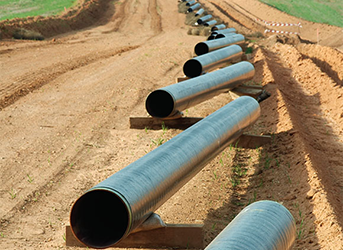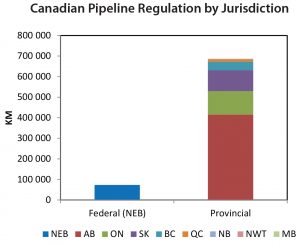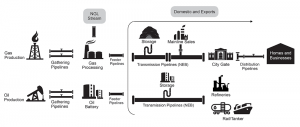
Who regulates Canada’s 760,000 km of pipelines?
Mike Edwards
Features gas National Energy Board NEB oil
There are more than 760,000 km of pipelines transporting hydrocarbons like oil and natural gas in Canada. That’s almost enough pipe to go to the moon and back. Most of these pipelines are regulated provincially, especially in Alberta (415,000 km), Ontario (114,000 km), and Saskatchewan (102,000 km).

The chart shows the total kilometers of regulated pipelines in Canada. The bar on the left shows approximately 73,000 km of pipelines regulated federally by the NEB – roughly 10 per cent of the Canadian total. The stacked bar on the right shows approximately 690,000 km of pipelines regulated provincially, with most of this in Alberta (415,000 km), Ontario (114,000 km), and Saskatchewan (102,000 km). Source: NEB
Pipelines that cross provincial boundaries or the Canada-U.S. border are regulated federally by the National Energy Board (NEB). The NEB is responsible for 73,000 km of pipeline, or roughly 10 per cent of the Canadian total. That’s almost twice the circumference of the Earth.
Gathering pipelines move products from wellheads to oil batteries/collection facilities or natural gas processing facilities. Feeder pipelines then move the products into storage tanks or transmission pipelines. Transmission pipelines transport products long distances within provinces and/or across provincial and international boundaries (the latter are regulated by the NEB). Distribution pipelines deliver natural gas directly to homes and businesses.
The vast majority of gathering, feeder, and distribution pipelines are regulated provincially. Transmission pipelines located entirely within a single province are also regulated provincially, while the NEB regulates transmission pipelines that cross provincial and international borders. The NEB engages provincial regulators through venues such as The Western Regulators’ Forum to promote collaboration and pursue mutual priorities.

This figure provides an overview of the Canadian oil and gas supply chain from production to downstream customers, including the role of the major types of pipelines.
Note that regulation of pipelines is separate from other areas of energy regulation. Provinces and territories are responsible for oil and gas production within their respective borders and the NEB only regulates exploration and production in specific areas of northern Canada.
Generally speaking, provinces and territories are also the lead regulators on which sources of energy which are used for electricity generation, heating, fuel, and other purposes. Other areas of energy consumption are regulated by many different levels of government, including municipalities and various federal and provincial departments. The NEB does not regulate energy consumption.
Print this page